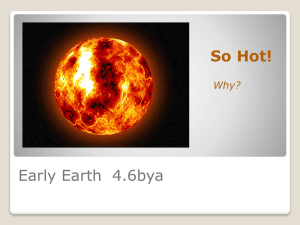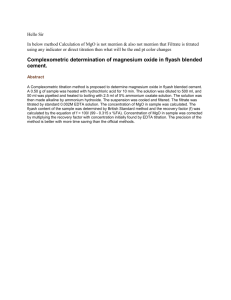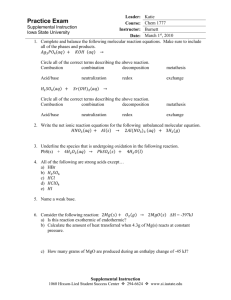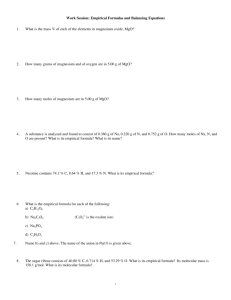Properties of (Mg Solid-solution at High Pressure Elastic ,Fe
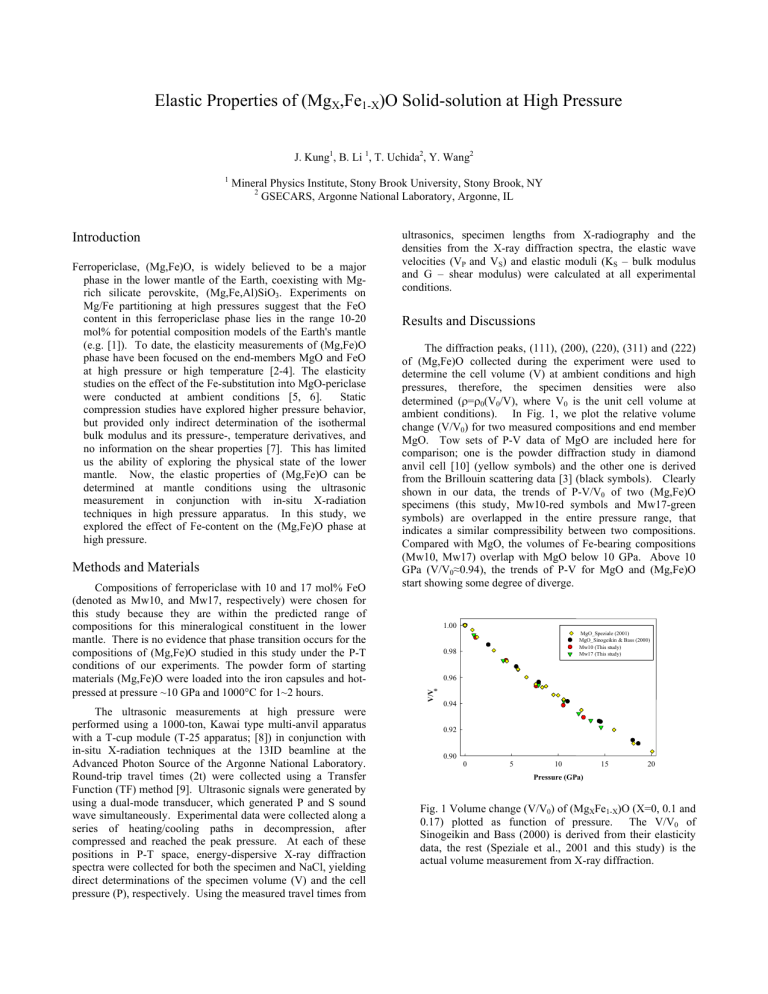
Elastic
P
roperties of (Mg
X
,Fe
1-X
)O
So
lid-solution at
Hi
gh
P
ressure
J. Kung 1 , B. Li 1 , T. Uchida 2 , Y. Wang 2
1 Mineral Physics Institute, Stony Brook University, Stony Brook, NY
2 GSECARS, Argonne National Laboratory, Argonne, IL
Introduction
Ferropericlase, (Mg,Fe)O, is widely believed to be a major phase in the lower mantle of the Earth, coexisting with Mgrich silicate perovskite, (Mg,Fe,Al)SiO
3
. Experiments on
Mg/Fe partitioning at high pressures suggest that the FeO content in this ferropericlase phase lies in the range 10-20 mol% for potential composition models of the Earth's mantle
(e.g. [1]). To date, the elasticity measurements of (Mg,Fe)O phase have been focused on the end-members MgO and FeO at high pressure or high temperature [2-4]. The elasticity studies on the effect of the Fe-substitution into MgO-periclase were conducted at ambient conditions [5, 6]. Static compression studies have explored higher pressure behavior, but provided only indirect determination of the isothermal bulk modulus and its pressure-, temperature derivatives, and no information on the shear properties [7]. This has limited us the ability of exploring the physical state of the lower mantle. Now, the elastic properties of (Mg,Fe)O can be determined at mantle conditions using the ultrasonic measurement in conjunction with in-situ X-radiation techniques in high pressure apparatus. In this study, we explored the effect of Fe-content on the (Mg,Fe)O phase at high pressure.
Methods and Materials
Compositions of ferropericlase with 10 and 17 mol% FeO
(denoted as Mw10, and Mw17, respectively) were chosen for this study because they are within the predicted range of compositions for this mineralogical constituent in the lower mantle. There is no evidence that phase transition occurs for the compositions of (Mg,Fe)O studied in this study under the P-T conditions of our experiments. The powder form of starting materials (Mg,Fe)O were loaded into the iron capsules and hotpressed at pressure ~10 GPa and 1000 ° C for 1~2 hours.
The ultrasonic measurements at high pressure were performed using a 1000-ton, Kawai type multi-anvil apparatus with a T-cup module (T-25 apparatus; [8]) in conjunction with in-situ X-radiation techniques at the 13ID beamline at the
Advanced Photon Source of the Argonne National Laboratory.
Round-trip travel times (2t) were collected using a Transfer
Function (TF) method [9]. Ultrasonic signals were generated by using a dual-mode transducer, which generated P and S sound wave simultaneously. Experimental data were collected along a series of heating/cooling paths in decompression, after compressed and reached the peak pressure. At each of these positions in P-T space, energy-dispersive X-ray diffraction spectra were collected for both the specimen and NaCl, yielding direct determinations of the specimen volume (V) and the cell pressure (P), respectively. Using the measured travel times from ultrasonics, specimen lengths from X-radiography and the densities from the X-ray diffraction spectra, the elastic wave velocities (V
P and V
S
) and elastic moduli (K
S
– bulk modulus and G – shear modulus) were calculated at all experimental conditions.
Results and Discussions
The diffraction peaks, (111), (200), (220), (311) and (222) of (Mg,Fe)O collected during the experiment were used to determine the cell volume (V) at ambient conditions and high pressures, therefore, the specimen densities were also determined ( ρ = ρ
0
(V
0
/V), where V
0
is the unit cell volume at ambient conditions). In Fig. 1, we plot the relative volume change (V/V
0
) for two measured compositions and end member
MgO. Tow sets of P-V data of MgO are included here for comparison; one is the powder diffraction study in diamond anvil cell [10] (yellow symbols) and the other one is derived from the Brillouin scattering data [3] (black symbols). Clearly shown in our data, the trends of P-V/V
0
of two (Mg,Fe)O specimens (this study, Mw10-red symbols and Mw17-green symbols) are overlapped in the entire pressure range, that indicates a similar compressibility between two compositions.
Compared with MgO, the volumes of Fe-bearing compositions
(Mw10, Mw17) overlap with MgO below 10 GPa. Above 10
GPa (V/V
0
≈ 0.94), the trends of P-V for MgO and (Mg,Fe)O start showing some degree of diverge.
1.00
0.98
0.96
MgO_Speziale (2001)
MgO_Sinogeikin & Bass (2000)
Mw10 (This study)
Mw17 (This study)
0.94
0.92
0.90
0 5 10
Pressure (GPa)
15 20
Fig. 1 Volume change (V/V
0
) of (Mg
X
Fe
1-X
)O (X=0, 0.1 and
0.17) plotted as function of pressure. The V/V
0
of
Sinogeikin and Bass (2000) is derived from their elasticity data, the rest (Speziale et al., 2001 and this study) is the actual volume measurement from X-ray diffraction.
Measured elastic moduli (Ks and G) of (Mg,Fe)O plotted against V/V
0
(compression) at high pressures, room temperature were compared with MgO from previous study [3]. Shown in
Fig. 2a and b, the shear moduli of MgO and (Mg,Fe)O are systematically decreasing when the Fe-content increases from zero up to 17 mol%. But the slopes of G-V/V
0
(Fig. 2a) are parallel to each other, indicating their pressure derivatives are similar. In contrast, the bulk moduli are slightly increasing as the Fe-content increasing; except some points from Mw10 at low pressure range (V/V
0
(V/V
0
=1~0.95). At higher pressure region
<0.95), the bulk moduli for Mw10 and Mw17 are overlapped. The outliners of bulk moduli from Mw10 at low pressure could not be explained by the crack closure, because it was not observed in S wave. Fig. 2b (Ks-V/V
0
) shown clearly, the slope of Fe-bearing phase (i.e. Mw17) is parallel to that of
MgO at lower pressure (V/V
0
=1~0.95, pressure below 10 GPa) and starts showing departure from MgO above 10 GPa (i.e.
V/V
0
<0.94). The acoustic measurement of bulk modulus (Ks) has echoed the behavior of P-V data.
240
220
200
FeO
180
160
170
160
150
140
130
120
(b) Ks
110
100
0.90
(a) G
0.92
FeO
0.94
MgO_Sinogeikin & Bass (2000)
Mw10 (This study)
Mw17 (This study)
0.96
0.98
1.00
V/V
0
Fig. 2 Elastic moduli (Ks and G) of (Mg
X
Fe
0.1 and 0.17) plotted as a function of V/V
0
1-X
)O (X=0,
. MgO is single-crystal Brillouin scattering measurement.
From this study, we found that the addition of FeO to MgO has strong effect on the shear modulus and weak effect on bulk modulus as shown in previous study [6]. Within the composition we studied here (<20 mol% Fe), the Fe-content has opposite effects on the elastic bulk and shear moduli of
(Mg,Fe)O (Fig. 2). Our data also suggest that the Fe-content may have some degree of effect on the compressibility (i.e. pressure derivative of bulk modulus) of (Mg,Fe)O at higher pressure region (above 10 GPa) (Fig. 2). Moreover, the equilibrium studies have demonstrated that the Mg/Fe partitioning between Mg-rich silicate perovskite and (Mg,Fe)O is as function of depth in the lower mantle. This implies that the forward modeling of the lower mantle has to take the effect of
Fe-content on the elasticity of these mantle phases as a function of depth into account. This comparative study has provided the necessary data to formulate the elastic properties of (Mg,Fe)O as a function of composition at high pressure.
Acknowledgments
Use of the Advanced Photon Source was supported by the U.S.
Department of Energy, Office of Science, Office of Basic
Energy Sciences, under Contract No. W-31-109-ENG-38. We also thank for the support of beamline 13-ID, GSECARS. Work suported by the NSF grant EAR 99-80491.
References
[1] Lee, K.K.M., B. O'Neill, W.R. Panero, S.H. Shim, L.R.
Benedetti, and R. Jeanloz, Earth Planet. Sci. Lett., 223, 381-
393 (2004).
[2] Isaak, D.G., O.L. Anderson, and T. Goto, Phys. Chem. Min.,
16, 704-713 (1989)
[3] Sinogeikin, S.V., and J.D. Bass, Phys. Earth Planet. Inter.,
120, 43-62 (2000).
[4] Jackson, I., S.K. Khanna, A. Revcolevschi, and J. Berthon,
Elasticity, J. Geophys. Res.
, 95, 21671-21685 (1990).
[5] Jackson, I., R.C. Liebermann, and A.E. Ringwood, Phys.
Chem. Min.,
3
, 11-31 (1978).
[6] Jacobsen, S.D., H.J. Reichmann, H.A. Spetzler, S.J.
Mackwell, J.R. Smyth, R.J. Angel, and C.A. McCammon, J.
Geophys. Res., 107 , art. no.-2037 (2002).
[7] Fei, Y., Mao, H-K, Shu, J., Hu, J., Phys. Chem. Min., 18,
416-422 (1992).
[8] T. Uchida, Y. Wang, M.L. Rivers, S.R. Sutton, D.J.
Weidner, M.T. Vaughan, J. Chen, B. Li, R.A. Secco, M.D.
Rutter, H. Liu, J. Physics-Condensed Matter 14, 11517-
11523 (2002).
[9] Li, B.S., K. Chen, J. Kung, R.C. Liebermann, and D.J.
Weidner, J. Physics-Condensed Matter, 14, 11337-11342
(2002).
[7] Speziale, S., C.S. Zha, T.S. Duffy, R.J. Hemley, and H.K.
Mao, J. Geophys. Res
.
, 106, 515-528 (2001).



